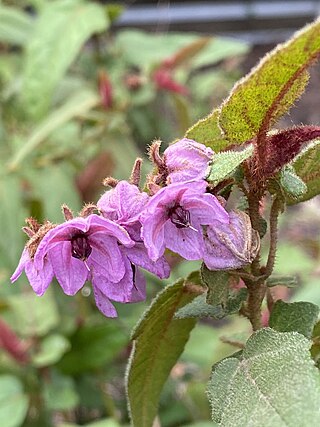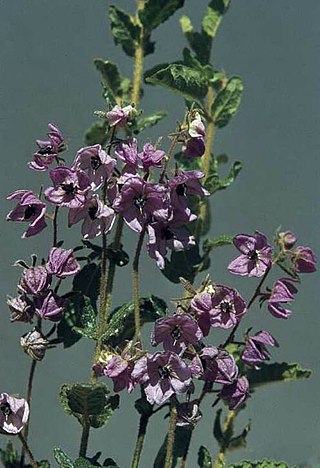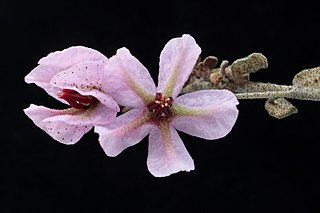
Thomasia tenuivestita is a species of flowering plant in the family Malvaceae and is endemic to the south-west of Western Australia. It is a shrub with its new growth covered with greyish, star-shaped hairs, and has egg-shaped leaves, and racemes of mauve flowers.

Thomasia quercifolia, commonly known as oak leaved thomasia, is a flowering plant in the family Malvaceae and is endemic to the south-west of Western Australia. It has egg-shaped, lobed leaves with a heart-shaped base, and pink to mauve flowers.

Thomasia purpurea is a small, flowering shrub in the family Malvaceae that is endemic to the southwest of Western Australia. It has green oblong-shaped leaves and pinkish purple flowers.

Commersonia corniculata is a species of flowering plant in the family Malvaceae and is endemic to the southwest of Western Australia. It is an erect to prostrate shrub with 3-lobed, egg-shaped leaves, and white to cream-coloured flowers.
Lasiopetalum compactum, is a species of flowering plant in the family Malvaceae and is endemic to the south-west of Western Australia. It is an erect shrub with leathery, narrowly oblong leaves and cymes of white to pinkish flowers.
Lasiopetalum cordifolium, is a species of flowering plant in the family Malvaceae and is endemic to the south-west of Western Australia. It is an erect shrub with hairy stems, heart-shaped leaves and pink, cream-coloured or white flowers.
Lasiopetalum ferraricollinum is a species of flowering plant in the family Malvaceae and is endemic to the south-west of Western Australia. It is an upright shrub with densely hairy stems, narrow egg-shaped to oblong leaves and white to cream-coloured and dark red flowers.

Lasiopetalum glutinosum is a species of flowering plant in the family Malvaceae and is endemic to the south-west of Western Australia. It is a spreading, multi-stemmed shrub with densely hairy young stems, egg-shaped leaves often with three lobes and bright pink or dark red flowers.
Lasiopetalum laxiflorum is a species of flowering plant in the family Malvaceae and is endemic to the south-west of Western Australia. It is a sticky, straggling subshrub or shrub with many densely hairy stems, egg-shaped leaves, and bright pink and dark red flowers.
Lasiopetalum monticola is a species of flowering plant in the family Malvaceae and is endemic to the south-west of Western Australia. It is an erect, slender or straggling shrub with densely hairy branchlets, leaves and flowers, egg-shaped leaves and pink, cream-coloured or white flowers.

Thomasia paniculata is a species of flowering plant in the family Malvaceae and is endemic to the south-west of Western Australia. It is a spreading shrub with heart-shaped to narrowly egg-shaped leaves and pinkish-mauve flowers.
Thomasia dielsii is a species of flowering plant in the family Malvaceae and is endemic to the south-west of Western Australia. It is a low, erect to spreading shrub with egg-shaped leaves with wavy edges, and purple, violet and blue flowers.

Thomasia discolor is a species of flowering plant in the family Malvaceae and is endemic to the south-west of Western Australia. It is a multi-stemmed shrub with densely hairy branchlets, coarsely serrated, egg-shaped leaves with a heart-shaped base, and many small pink, cream-coloured or white flowers.
Thomasia × formosa is a species of flowering plant in the family Malvaceae and is endemic to a restricted area of the south-west of Western Australia. It is an erect, compact shrub with densely hairy branchlets, hairy, coarsely serrated, egg-shaped to elliptic or oblong leaves, and racemes of pink or purple flowers arranged in leaf axils.

Thomasia macrocalyx is a species of flowering plant in the family Malvaceae and is endemic to the south-west of Western Australia. It is an erect, bushy shrub with densely hairy new growth, egg-shaped leaves with a heart-shaped base and lobed or toothed edges, and groups of pale purple to mauve or white flowers.

Thomasia microphylla is a species of flowering plant in the family Malvaceae and is endemic to the south-west of Western Australia. It is an erect, spreading shrub with egg-shaped leaves and racemes of pale pink or mauve flowers.

Thomasia pauciflora, commonly known as few-flowered thomasia, is a species of flowering plant in the family Malvaceae and is endemic to the south-west of Western Australia. It is a slender, erect or straggling shrub with egg-shaped leaves and pink to purple, occasionally white flowers.

Thomasia stelligera is a species of flowering plant in the family Malvaceae and is endemic to the south-west of Western Australia. It is a low, spreading shrub with scattered, narrowly oblong leaves, and racemes of mauve flowers.
Thomasia tremandroides is a species of flowering plant in the family Malvaceae and is endemic to the south-west of Western Australia. It is an erect or low, spreading shrub with many stems, flimsy, papery, egg-shaped leaves and racemes of papery, mauve to pink flowers.

Seringia cacaobrunnea, commonly known as chocolate fire-bush, is a species of flowering plant in the family Malvaceae and is endemic to the south-west of Western Australia. It is a bushy shrub with hairy new growth, oblong to elliptic leaves and purple flowers in groups of 3 to 11.














